Key takeaways:
- Family migration stories provide deep emotional connections to our roots, revealing personal sacrifices and the relentless pursuit of hope.
- Engaging in genealogy research fills in historical gaps, fostering a sense of identity and continuity through the experiences of our ancestors.
- Collecting oral histories from relatives uncovers rich details and emotional treasures that enhance our understanding of family identity.
- Documenting migration findings, including personal narratives and historical context, transforms research into a meaningful exploration of challenges and triumphs faced by ancestors.
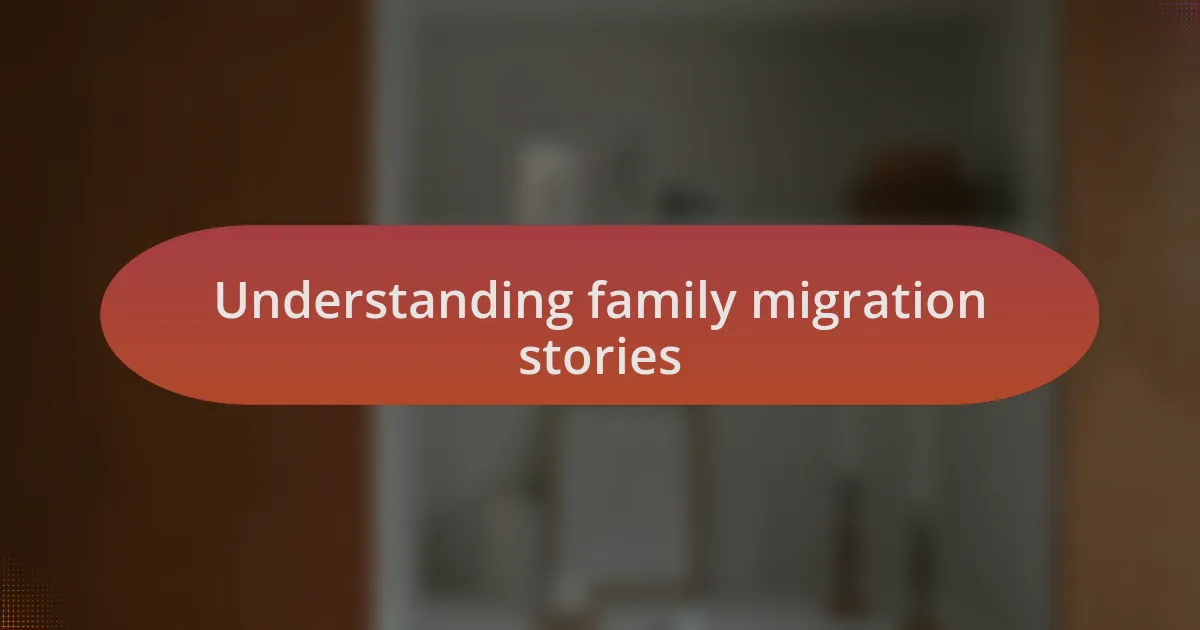
Understanding family migration stories
Understanding family migration stories can be an emotional journey that connects us to our roots in profound ways. I remember sitting with my grandmother, listening as she recounted her journey from Italy to the United States. Her voice carried a mix of pride and sadness, revealing the sacrifices made for a better life. Isn’t it fascinating how these narratives shape our identities?
As I delved deeper into our family’s history, I discovered letters that described not only the logistical challenges of migration but also the deep personal yearnings for home. These letters brought tears to my eyes, showing me that migration isn’t just about changing locations; it’s filled with dreams, fears, and the relentless pursuit of hope. Have you ever thought about the emotional weight carried by those who migrate?
Every migration story is unique, reflecting the broader tapestry of human experience. I often wonder about those who remained behind, and how their lives diverged from the paths taken by migrants. Understanding these stories fosters empathy and connection, reminding us that beneath the historical facts are real lives filled with struggle and resilience.
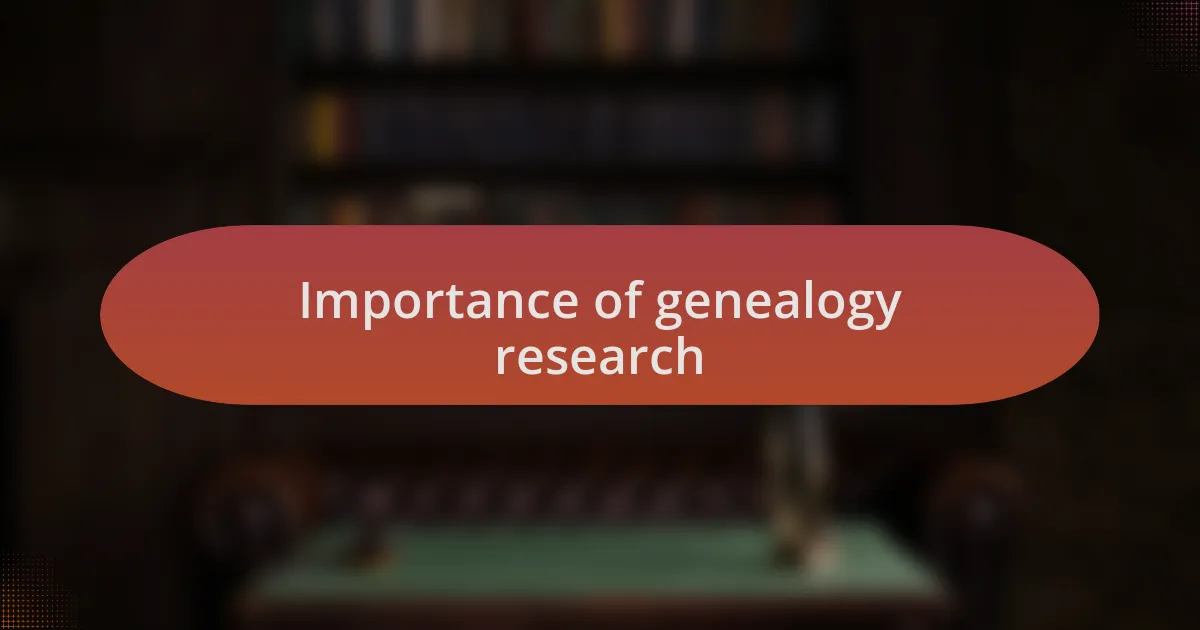
Importance of genealogy research
Genealogy research is crucial because it allows us to piece together the fragments of our ancestors’ lives, filling in the gaps that history often overlooks. I recall the day I stumbled upon an old family tree, revealing names and connections I never knew existed. It felt like unearthing a treasure trove of identity and belonging—who wouldn’t feel a rush of excitement discovering how their family fits into the larger narrative of our shared history?
Exploring genealogy isn’t just about tracing lines on a chart; it’s about understanding who we are through the experiences of those who came before us. As I analyzed historical records and census data, I could almost hear my great-great-grandfather’s footsteps on the very streets he walked. Have you ever felt a jolt of connection to your past in unexpected places? This type of research deepens our understanding of migration, revealing the resilience required to start anew in foreign lands.
Moreover, genealogy fosters a sense of continuity in an ever-changing world. As I connected with distant relatives through online forums, I found comfort in their stories of resilience and perseverance. Isn’t it incredible to think that these shared experiences can transcend time and distance? Through genealogy, we not only learn about our family’s journey but also about the shared human experience of migration—that universal search for home and belonging.
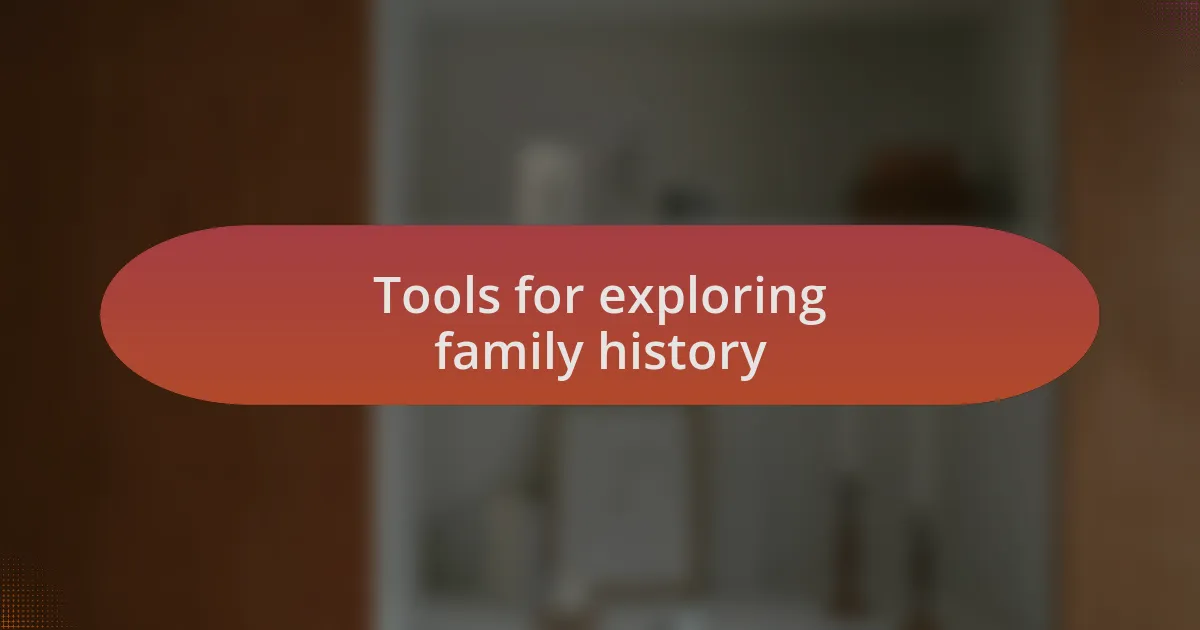
Tools for exploring family history
When diving into family history, several tools can enhance your research journey. For instance, I frequently rely on online databases like Ancestry.com or FamilySearch.org, which offer access to a plethora of historical documents, from birth certificates to immigration records. Have you ever found a name that sparks a memory or raises questions about your family’s past? That thrill is invigorating, and these platforms make it so accessible.
Census records are another invaluable resource. I remember the first time I accessed a census from the early 1900s, spotting my ancestors’ names listed as they settled into their new lives. Seeing where they lived and the professions they held gave me a vivid snapshot of their world. It’s amazing how one document can transform abstract names into real people with hopes and challenges.
DNA testing has also revolutionized how we explore our genealogy. After taking a DNA test, I was astonished to discover relatives I never knew existed, connecting me to a larger family network. This experience raised questions about identity—how much of who we are is influenced by those we have never met? Engaging with DNA databases has opened a door to a richer understanding of my heritage and the stories we all carry within us.
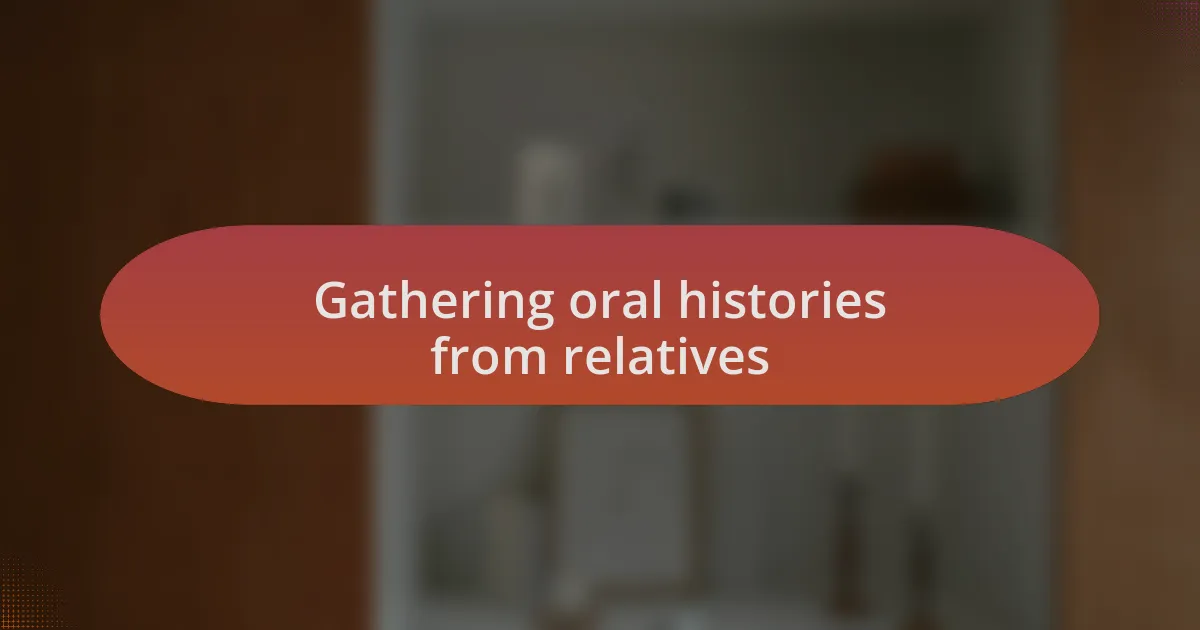
Gathering oral histories from relatives
Gathering oral histories from relatives can truly illuminate the nuances of family narratives. I vividly recall sitting with my grandmother as she shared her childhood experiences during World War II. Listening to her speak, I realized how her memories were not just stories; they were emotional treasures that shaped our family identity. Have you ever had a moment where the past felt so alive? Those conversations can spark a deep connection to our roots.
One of the most rewarding parts of collecting these stories is discovering unexpected details. For example, my uncle casually mentioned the family’s connection to a local landmark, a beautiful old theater that many family gatherings revolved around. This new insight prompted me to explore not just our ancestors’ lives, but also the social and cultural aspects of their world. How often do we overlook the richness in our family histories by not asking the right questions?
I’ve found that sometimes, the best stories come when we least expect them. During a family reunion, I asked my cousin about his recent trip to our ancestral homeland. The stories he shared were filled with laughter, heartache, and connections to relatives I had only known through photographs. These moments weave together the fabric of our family history, reminding us that the stories we gather enhance our understanding of who we are today. Isn’t it fascinating how a simple question can unlock a treasure trove of memories?
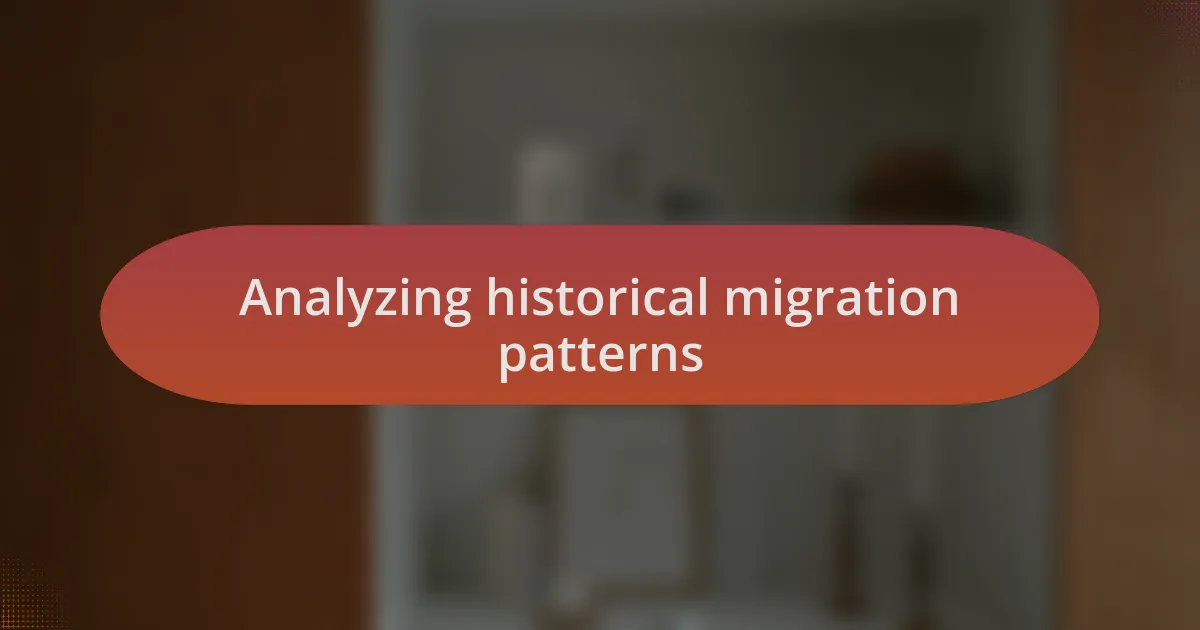
Analyzing historical migration patterns
Analyzing historical migration patterns reveals fascinating insights about how our ancestors navigated their worlds. I often pondered why my great-grandparents moved from Eastern Europe to the United States in the early 1900s. Reading about the socio-economic factors at play during that time made me appreciate their resilience. The surge of people seeking better opportunities resonates with anyone who has felt the urge to seek change.
Diving deeper into migration data, I discovered significant patterns tied to historical events, like the migration waves influenced by wars or economic crises. For instance, many families, including mine, fled hardships during the Great Depression seeking hope in America. Have you ever wondered how those pivotal moments shaped the journeys of countless families like ours? It’s eye-opening to realize that behind every name on a family tree lies a story connecting them to broader historical narratives.
As I analyzed these patterns, I found emotional resonance in the struggle and triumph experienced by my ancestors. One particular story struck me: my great-aunt’s desperate journey across the Atlantic, leaving everything behind but her dreams. This tale illustrates how migration is not just a physical relocation; it embodies hope, sacrifice, and the universal desire for a better life. Each migration story, including my family’s, reflects the intricate tapestry of human experience. What does your family migration story say about resilience and hope?
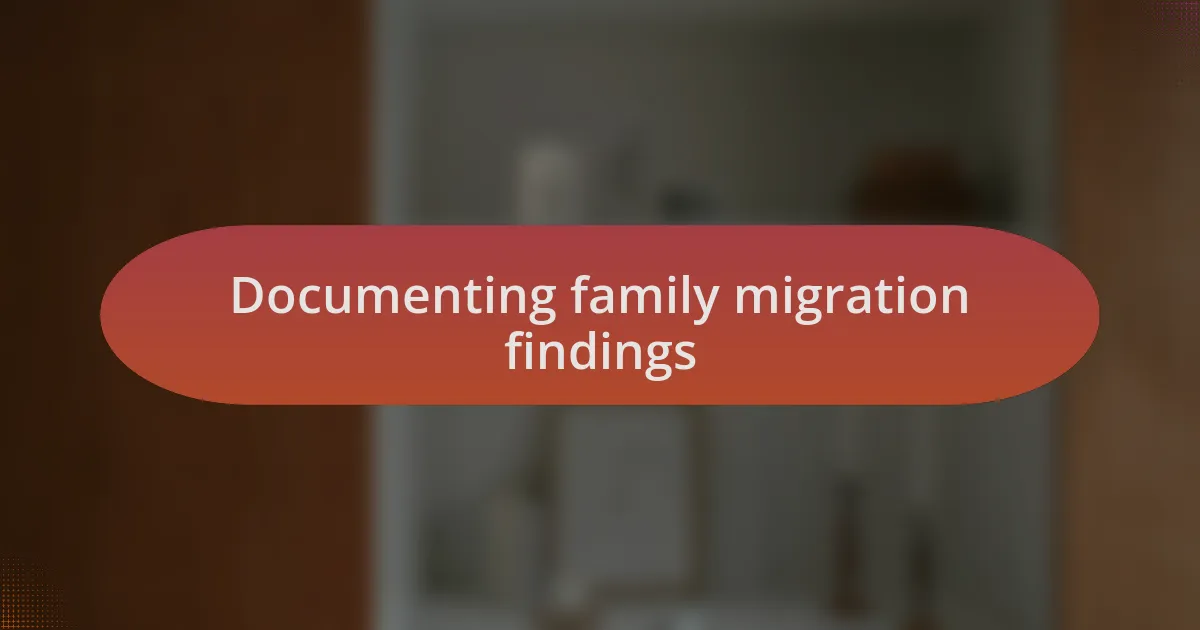
Documenting family migration findings
Documenting family migration findings can be a deeply rewarding experience. I remember sitting with my grandmother, sifting through old letters and photos, piecing together her family’s history. Those documents not only revealed names and dates but also the emotions tied to each journey—they were snapshots of courage, heartache, and unwavering hope.
As I compiled these findings, I realized the importance of context in understanding each migration story. For example, my family’s decision to migrate wasn’t made lightly; it was often driven by fear, loss, and the desperate need for safety. Have you ever considered how your family documents might reveal sacrifices that shaped your lineage? This realization brought me closer to my ancestors, as I began to appreciate the weight of their decisions.
Additionally, I created a digital timeline, integrating historical events with personal narratives. This method not only helped streamline my research but also turned my family’s migration saga into a visual journey. Seeing the timeline unfold added a layer of depth; it transformed raw data into a lived experience. How might you visualize your family’s migration to better understand their challenges and triumphs?